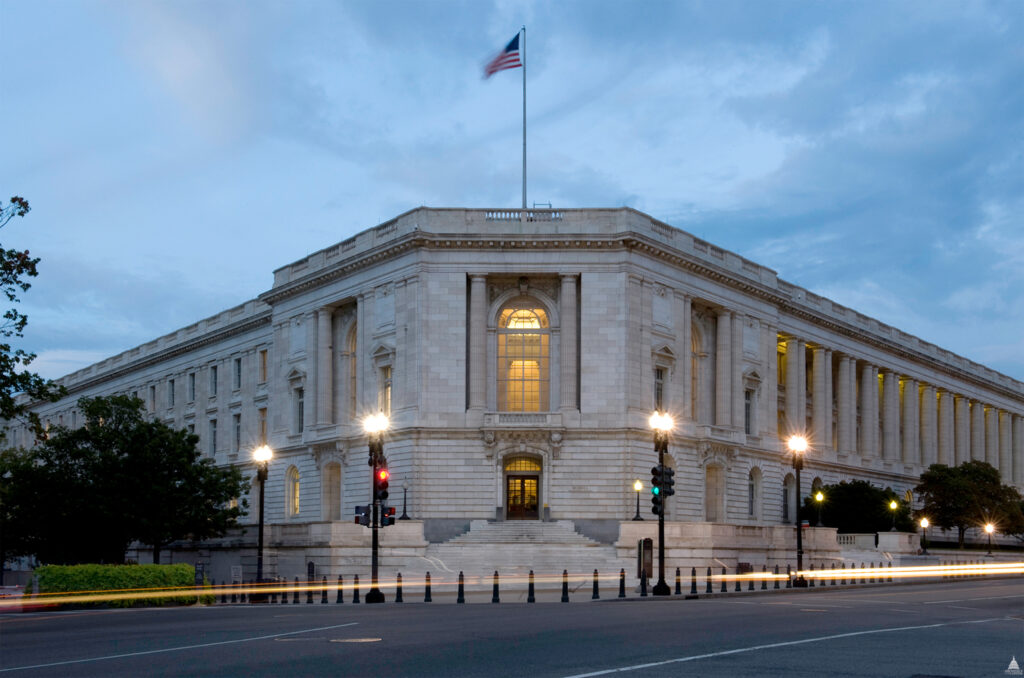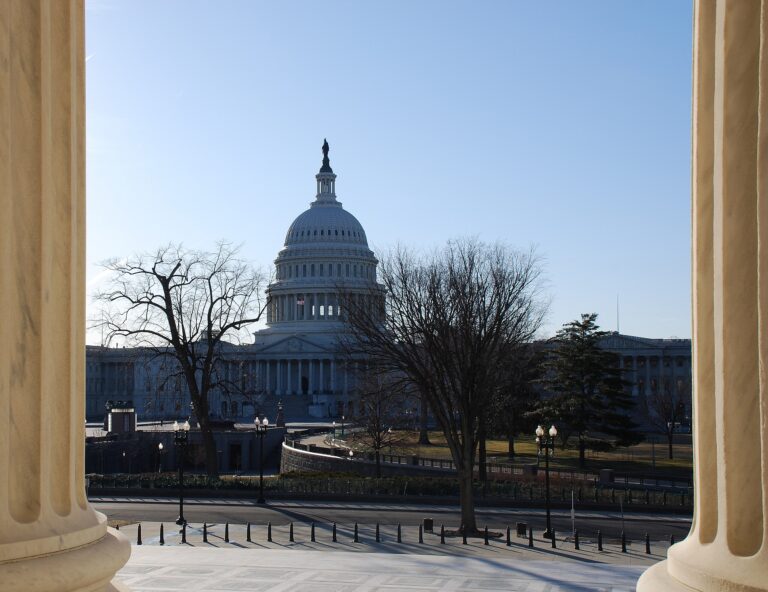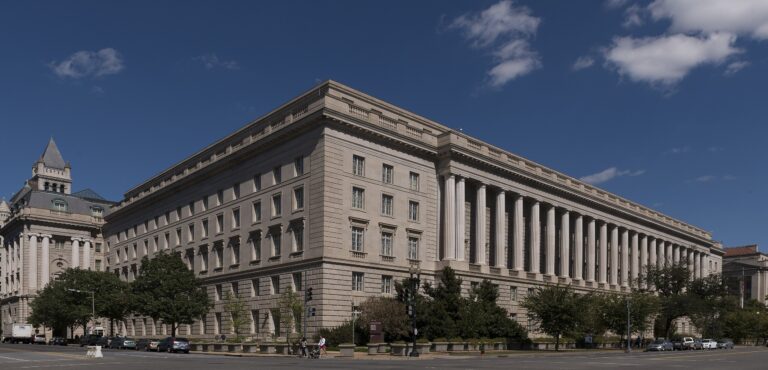
Does Religious Peacekeeping Still Matter If It Doesn’t Produce Peace?
Peter Henne
Russell Senate Office Building by Architect of the Capitol (US-PD).
During his second term, President Barack Obama attempted to restart the Israel-Palestine peace process, following in the footsteps of every president since George H.W. Bush. Like other attempts, it fell apart quickly, much to the frustration of all. In April of 2014, then U.S. Secretary of State John Kerry testified before the US Senate. Reacting to their frustration, he said, “You want to dump it on me? I don’t care, I may fail,” but he added that “it’s worth doing, it’s worth the effort.”
That last line—“It’s worth doing, it’s worth the effort”—likely resonates with many who study or engage in religious peacebuilding. Those who work in this area tend to have a strong belief—possibly even faith—in the power of religion to bring peace. But its impacts are elusive. Scholarly studies have struggled to conclusively demonstrate that religious peacebuilding has a consistent positive effect on conflict. The situation is even more punishing for those involved in these efforts, as they often select themselves into the most brutal, obdurate conflicts that show little hope of ending.
Maybe, however, those attempting to discern whether religious peacebuilding is impactful are looking in the wrong place. Maybe it will not, and cannot, produce another durable peace agreement, another Oslo Accords. Maybe, instead, the effort itself is the goal.
The frustrations of studying religious peacebuilding
Could Secretary Kerry’s assertion be true, that the effort of peacebuilding is worth it, despite the outcome? And could this apply to the often difficult world of religious peacebuilding? If so, this can help resolve issues in the scholarly study of the topic.
First, several works assert that religious peacebuilding exists. As anyone who engages on religious issues knows, that is not always obvious. The scholarly and policy communities have long ignored the role of religion, or saw it only as a problem. So it is useful to demonstrate its significance and understand how it works. Studies in this area include classic texts on religious peacebuilding that called on U.S. policymakers to recognize the important role religion plays in the world. It also includes case studies on key conflicts. And it includes studies on the mechanics of religious peacebuilding.
Another set of works have tried to demonstrate that religious peacebuilding not only exists, but matters. Some have applied this to small-group settings. There have also been numerous case studies exploring examples of religious peacebuilding. Additionally, there are several quantitative analyses of religious peacebuilding’s impact. Finally, there have been some critical takes on the topic of religious peacebuilding. Scholars have questioned built-in assumptions in definitions used, and adopted interpretive frameworks to understand how religious peacebuilders view their work.
Issues with existing work
Despite this growing set of research, scholars have not conclusively demonstrated the positive impact of religious peacebuilding. While case studies of religious peacebuilding are well-done, they are often presented as examples rather than causal analyses. In order for qualitative studies to demonstrate a causal impact we need structured comparative studies or a discussion of the case selection to know how we can generalize beyond one case. Likewise, quantitative studies tend to have mixed results. They have found some impact of religious organization involvement in peace processes but this tends to be confined to non-religious conflicts.
There have also been a few explicit critiques of religious peacebuilding’s effectiveness. Barbara Walter questioned the common assumption that the Roman Catholic San Egidio community’s intervention in the Mozambique civil war is what led to that conflict’s resolution. She pointed out that the war continued for several years after San Egidio’s involvement, with peace arising from the rationalist design of the ultimate peace agreement. Other critiques came up in my latest book, when I was interviewing practitioners of religious engagement in U.S. counterterrorism. Several interviewees noted it was hard to point to broad-based successes of these initiatives, or even how to tell if they were working.
Taking all this together, there is an empirical and methodological issue with current attempts to make the case for religious peacekeeping. Empirically, it seems that religious peacebuilding does not lead to peace in most cases. Either it is ineffective or is tangential to the factors that ultimately produced peace. Advocates for religious peacebuilding are left pointing to a few isolated—if prominent—examples, such as Northern Ireland. Methodologically, the impacts of religious peacebuilding may not be discernible as currently defined or studied. Most studies seek tangible markers such as the end of conflict or the implementation of a peace agreement. They then couple these markers with careful quantitative or qualitative research design isolating the effect of religious peacebuilding. The impacts of religious peacebuilding, if they exist, may not be identifiable in such a manner.
Rather than abandoning causal analysis and embracing postmodern interpretive approaches, it may be better to adjust what we mean by the effects of religious peacebuilding and where we expect to find them.
A different approach to peace
One way to do this is to clarify, and possibly change, what we mean by peace. Peace scholars have already made great progress on this. Many oppose being satisfied with a negative peace that is just the absence of conflict. Instead, they call for a positive peace that includes building the infrastructure to address the root causes of conflict. Others have emphasized the need for a just peace, that peacebuilding needs to emphasize addressing the grievances and harm of those affected by conflict, not just ending the conflict. Finally, some have discussed a relational peace, in which peace is conceived as a type of relationship with stable patterns of interactions, subjective recognition of all in society, and shared beliefs of fellowship.
the true impact of religious peacebuilding lies at the intersection of just peace and relational peace. Religious peacebuilding may not produce the sort of dramatic peace agreements we look for when studying peace, but it produces its effects on the types of relations that exist in society.
One type of effect exists at a more local level than most studies currently focus on. Religious peacebuilding can produce bubbles of peace, or local everyday practices that create peaceful relations in the midst of broader conflict. Specific villages can live in peace. Or sectarian tensions that would normally tear a community apart may be restrained. Religious organizations are often integral to such efforts. These bubbles may not be apparent when viewing things like peace agreements and country-level—or even region-level violence—but they are significant. For example, interviews in Sierra Leone found that small-scale religious peacebuilding efforts during that country’s civil war established broader patterns of cooperation that contributed to post-conflict stability.
The second is more radical: that the very process of engaging in religious peacebuilding is the desired impact. By presenting a version of faith that does not enable violence, or demonstrating the imperative of interfaith dialogue, religious peacebuilding can transform relations in a conflict. They change an interaction from combat to one based on recognition, both thin recognition of each other as people or a deeper thick recognition in which you empathize with the others’ concerns. This recognition is one of the theorized foundations of just peace, but even if it does not build into broader peace it still alleviates suffering in a conflict.
Finally, for people of faith, acting in line with their faith—and seeing others act in line with their faith—is important on its own. A passage from the New Testament is relevant here. Hebrews 11:1 (according to the New International Version) states “faith is confidence in what we hope for and assurance about what we do not see” In the midst of a horrific conflict, acting out a religion’s call for peace is a testament to that faith, while observing such acts can be a source of reassurance for those affected by conflict. This can be seen in evangelical Christian peacebuilding in the Nicaraguan civil war, which some participants described–using religious terms–as their “calling.”
Where can we find the small-scale impacts of religious peacebuilding?
Unfortunately, there are numerous examples of conflicts in which religious peacebuilding did not produce a durable peace agreement. But that does make it easier to highlight the nature of religious peacebuilding I am discussing here.
We can look to Pakistan for the impact of religious peacebuilding even during ongoing conflict. Pakistan has long suffered from religious violence arising from various sources. Some of it is sectarian tensions, some has to do with blowback from government support for Kashmiri and Afghan militants. Other tensions have arisen from military campaigns along the Afghan-Pakistan border. There have been periodic domestic and international efforts to resolve these tensions, but religious conflict persists.
Yet, studies on peacebuilding efforts in the country—notably sociologist Anita Weiss’s excellent 2020 book—highlight areas religious organizations have had an impact. There are numerous organizations that are engaged in interfaith dialogue. This includes the Interfaith Council for Peace and Harmony (ICPH), which holds regular meetings of Muslim and Christian leaders and encourages cross-faith attendance at religious ceremonies. It also includes the Peace Education and Development Initiative, which expanded from its secular conflict resolution mission to incorporate religious leaders into trainings. And there is the Interfaith Harmony group, which holds regular inter-faith meetings of professors and students at universities.
We can find many impacts from these organizations. Members of the ICPH noted that attending each others’ houses of worship is a new development that will “cultivate” harmony. The Interfaith Harmony group noted that its work has led it to “come to [members’] minds that we can all sit together.” One group managed to defuse religious tensions in a village after a Christian teacher was alleged to have forced his faith on Muslim students. And some have seen their work as living their faith in the world.
Sri Lanka, by contrast, may be a case where religious peacebuilding seems to have failed. The country suffered a devastating, decades-long civil war between the Sinhalese Buddhist majority and Tamil Hindu minority. Despite peacekeeping efforts and international mediation, it ended only with the complete defeat of the rebel Liberation Tigers of Tamil Eelam (LTTE) by the government. Sectarian tensions persist, however, as seen in the 2019 bombings of Christian churches on Easter.
As studies of peacebuilding efforts in Sri Lanka have shown, however, religious organizations were both active and impactful. The Center for Performing Arts in Jaffna put on plays by both Sinhalese and Tamil artists for mixed audiences. Both the Community Education Center and the Council of Religions organized Sinhalese visits to Tamil refugee camps. And the Sarvodaya organization facilitated grassroots organizing for peace.
Despite the way the war ended, there were several visible impacts of these efforts. Participants in the refugee camp visits—and residents of the camps who met the visitors—reported a realization that those on the other side of the conflict are not bad people, enabling the thin recognition necessary for peaceful relations. And there were some examples in which LTTE attacks would normally have led to Sinhalese reprisals against Tamil communities, but intervention by these groups maintained localized peace.
Maintaining faith in religious peace
It is easy to lose hope in the impact of religious peacebuilding. Clear examples of its impacts are few and far in between. Conflicts around the world keep spreading and intensifying, and damaging religious ideologies seem to be contributing to them. But those on the ground—both those affected by conflicts and those trying to resolve them—may see things differently. They may value the small-scale impacts of religious peacebuilding that are easily overlooked and dismissed by conventional analyses. They may even see the very attempt at peacebuilding by religious organizations as comforting. Scholars and practitioners should be aware of these local perceptions, and figure out a way to measure their impacts and support these efforts. ♦
This is taken from a new research project by the author, “Incomplete Religious Engagement.” A previous version of this work was presented at the “Religion, Conflict and Peace in Turbulent times” workshop at Uppsala University, June 2025.

Peter S. Henne is a Professor of Political Science and Director of the Middle East Studies Program in the College of Arts and Sciences at the University of Vermont. His most recent book is Religious Appeals in Power Politics (Cornell University Press, 2023).
Recommended Citation
Henne, Peter. “Does Religious Peacekeeping Still Matter If It Doesn’t Produce Peace?” Canopy Forum, July 18, 2025. https://canopyforum.org/2025/07/18/does-religious-peacekeeping-still-matter-if-it-doesnt-produce-peace/.
Recent Posts










